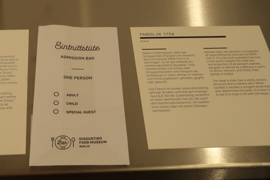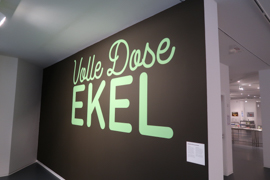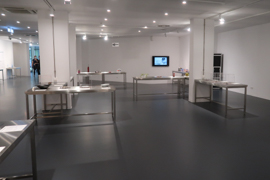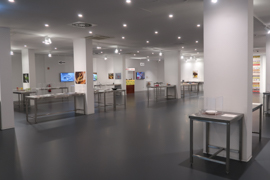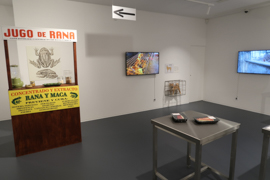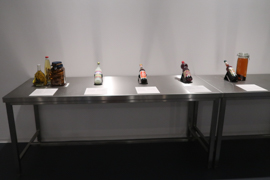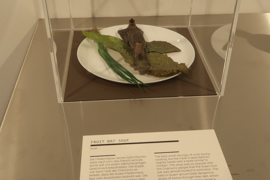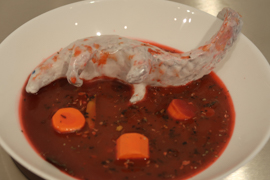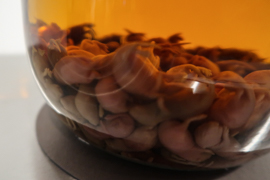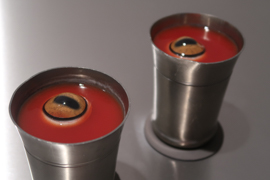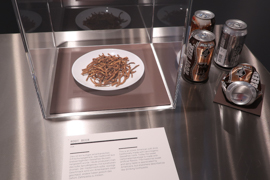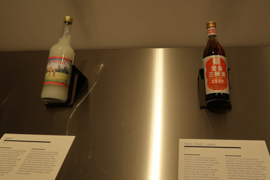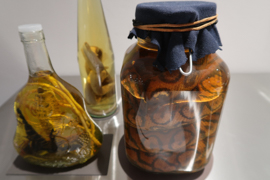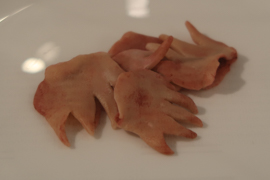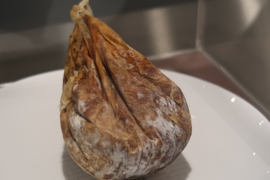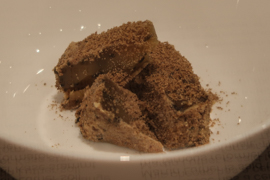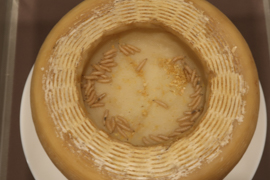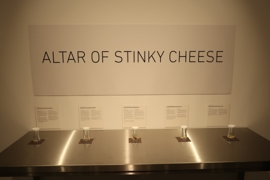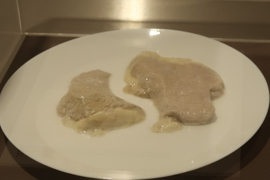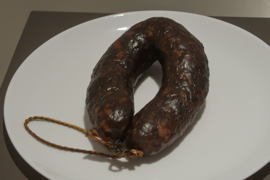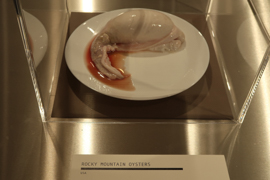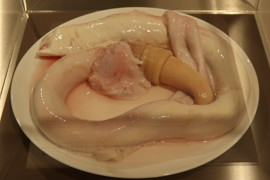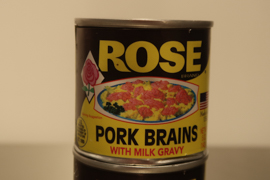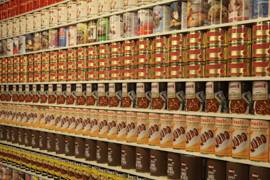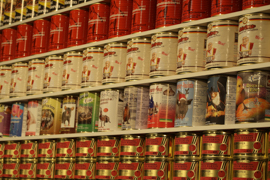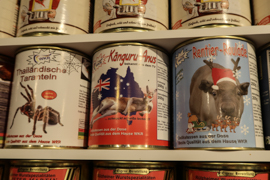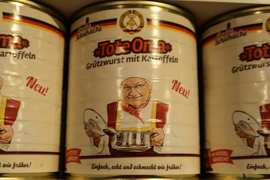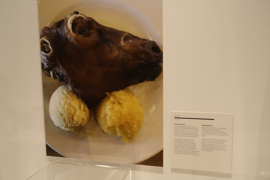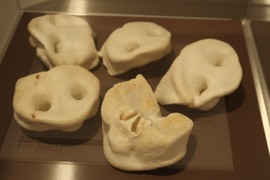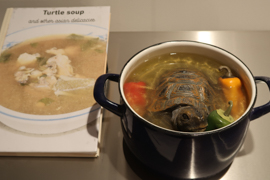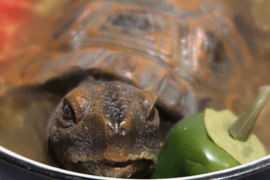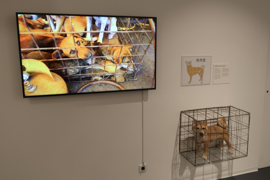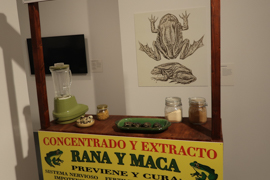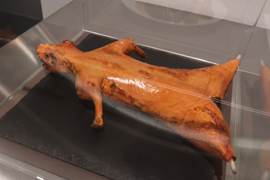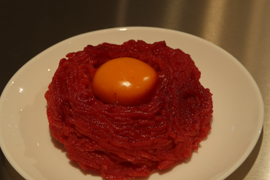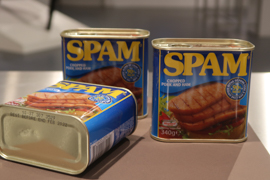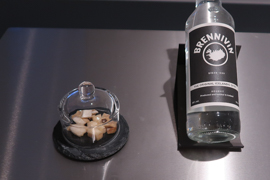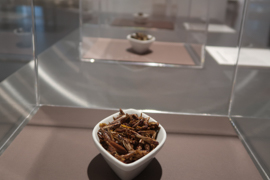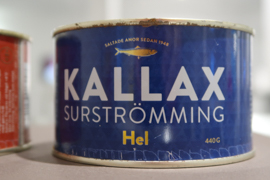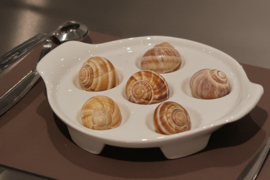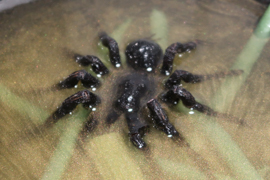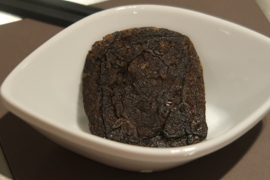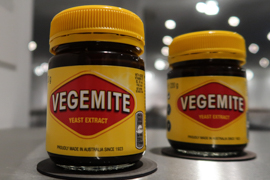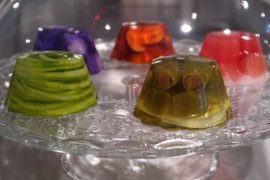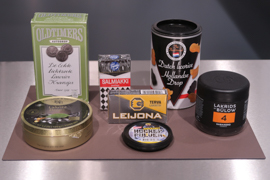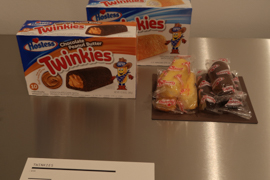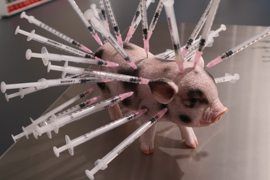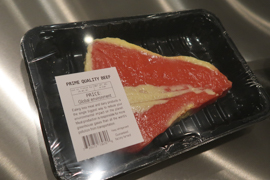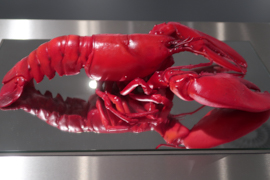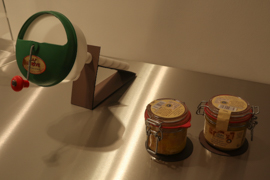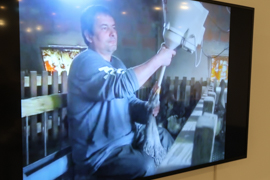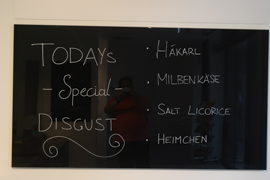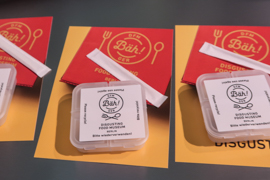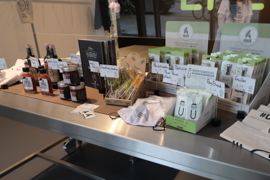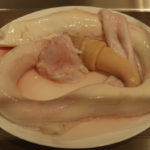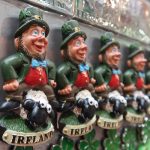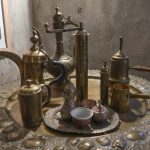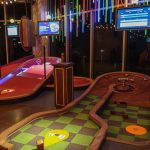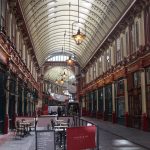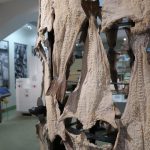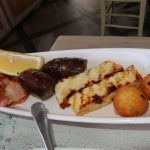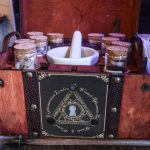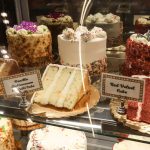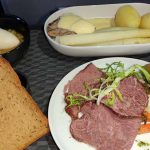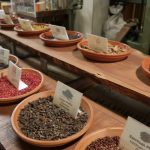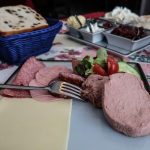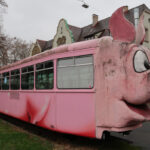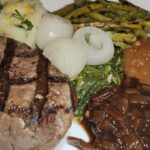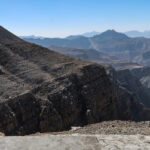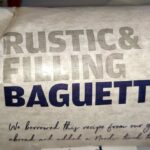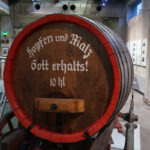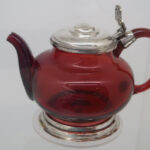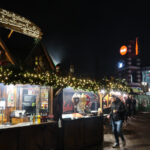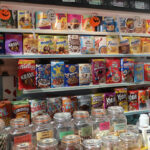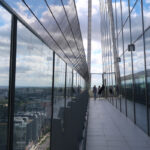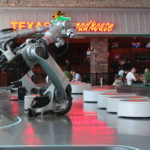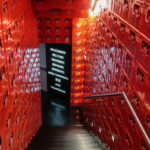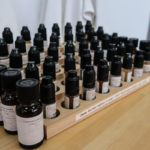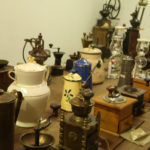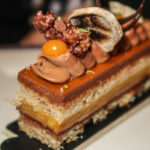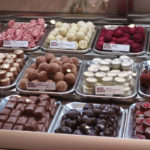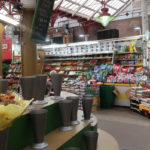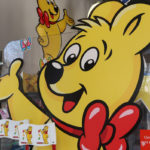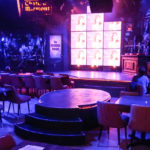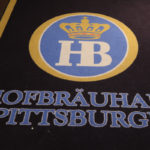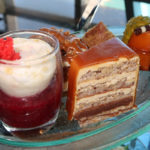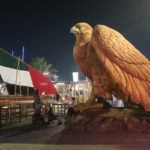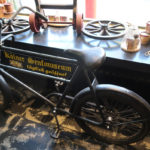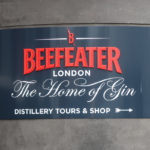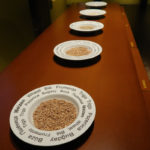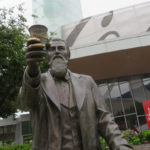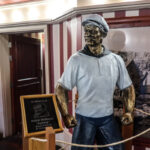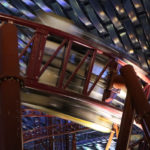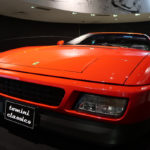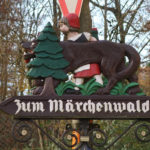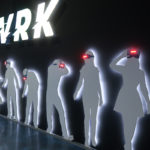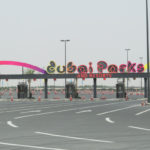Disgusting Food Museum Berlin
12 Euro
Flyctory.com Pros
- Great collection of disgusting food
- Very kind staff and services
- A small tasting box at the end of the visit
Have you ever heard of Surströmming, Hakarl or Spam? Do you mind eating eyes or drinking cow blood? All these local delicacies got now their own Hall of Fame in Berlin (in fact, there is also an outlet in Malmö, Sweden). The Disgusting Food Museum in Germany’s capital received quite a lot of nationwide media attention – and so I just had to visit the place, which was anyway not too far from my July 2021 overnight in Berlin. Here are my thoughts.


Disgusting Food Museum – Location & Admission
The Disgusting Food Museum is located at the Schützenstraße, a street crossing the famous Friedrichstraße in the heart of Berlin. It is a bit of tricky to find (also as Google is not absolutely precise), the yellow banners should help you, though. I would not absolutely recommend to drive there, if not absolutely necessary. The Hilton Berlin, for example, is driving a garage in close proximity.
I would rather suggest a bike or taking the U2 or U6 underground train to Stadtmitte and walk from there. Other attractions like Checkpoint Charlie and the Berlin Wall Panorama or the Gendarmenmarkt as well as all Unter den Linden attractions are just a short walk away.
At the time of visit, the museum was opening Friday to Tuesday, 11:00 to 19:00 hrs. You could buy time slot tickets, but this is rather a Covid-19 measure. Adult admission was 12 Euro.
Disgusting Food Museum – The Visit
The style of the museum is very neutral and unfussy. Most of the exhibits are put on metal tables and thus feel a bit like in fact being prepared in a professional kitchen. Few dishes are original, most are in display in very good plastic-alike illustrations – you would likely not stand the smell if all were real. There is a lot of information to each individual dish, which is really interesting to read. All signs are in German and English, so that you can definitely visit the museum even if you don’t speak German. A fun fact: your admission is not a ticket, but a barf bag – one day, when they can offer more tastings (see below), definitely not a bad thing.






The order in which I present the pictures in here is roughly the order I used during my visit (doing the tables in anti-clockwise order from the entrance). One of the first exhibits is about drinking cow blood, then you learn that parts of Germany put beaver liquids into a liqueur or cultures put very young mouse babies into alcohol. Eating reptiles or bats feels kind of “normal” compared to that. I really hate when animals are tortured for food production. The snake, for example, is sedated by cold, gutted but then brought back to life for a short moment before she ends up in the liquid.











Have a Nose or two at the “Altar Of Stinky Cheese”
Cheese is of course a classic food which may turn you into disgust if you are not used to it. In the first row, you see a cheese from Saxony, which is in fact fermented with mites – you finally eat both, the cheese and the mites, in case you dare. On the right, there is a Sardinian special dish, Casu Marzu, where sheep milk cheese is covered with a special fly, whose maggots give the cheese the final touch (this treatment can be seen in the museum). If that’s not enough for you, you might try out a couple of smells on the Altar of Stinky Cheese. I love cheese, but I am not too much into these ones.




I also liked to see what people seem to find disgusting: Flönz / Blutwurst (bloody sausage) is a Cologne speciality and very popular. However, I neither like real oysters (not part of the museum) nor Rocky Mountain Oysters (or Prairie Oysters, if you want to have the Canadian wording), which are in fact bull testicles. The intimacy of these animals seem to be very attractive for some people – the second row of pictures below shows the pecker of a bull. Delicious! One part of the museum I loved are all the canned dishes they majorly present on the rear wall of the museum.










Turtle Soup and Friends – Some Classics
The next section of the museum features a couple of “How can you eat that” classics. Turtle soup, frogs, dogs and guinea pigs just have to be part of this place. I would agree with US-American spam, but beef tatar is actually not that bad. I was a bit surprised that they do not show German mett, raw minced pork, which is a quite popular one here.








You finally run into a couple of dishes people think about very often when they think of disgusting food. Hakarl is an Icelandic shark dish which is typically served with a lot of alcohol to be able to stand it. Insects are more and more discussed as a source of protein. I already mentioned Surströmming, the Scandinavian fermented herring dish, which is famous for its terrible smell. The museum states that a court decided it is legal if the landlord is is immediately terminating the contract with the tenant for opening a can of that one indoors. In Sweden, you are not allowed to have that in your luggage on an airplane. Similar applies to the Durian in Singapore. Funny to see that you in fact have tried some of these dishes in the past.










Disgusting Day To Day Food
What I absolutely liked is that the museum is also pointing on food, which is disgusting for the conditions under which it is typically produced. The US American cake thing in the first picture is known for being that loaded with preservatives and food additives that it is very unlikely it will ever go to waste. Pork is criticized for the amount of antibiotics and beef for the massive ecologic impact. There are also some dishes which changed their role over time. Did you know that lobster used to be a dish for the poor? Finally, there is foie gras. I would recommend to visit the museum for the sake of seeing how that stuff is produced in France (which is illegal in all other parts of Europe, by the way).






Disgusting Food Museum – Tasting & Services
The staff in the museum was amazing. The young lady at the reception did great at the Altar of Stinky Cheese presentation, but also knew a lot about the food they displayed in the Berlin place. It was really great to chat and discuss with her – I learned a lot from both, the museum and the discussion. The museum also wants to increase offering tastings in the future – but at least you got a box with four little tastings at the end of your visit. The dishes of the day were Hakarl, Salt Licorice, the Saxony cheese with mites and crickets. You had to eat them outside due to hygienic limitations.I tried them all, but some of the dishes were just too disgusting for me.
Will be fun to visit the place again when there are wider tastings available. Some dishes like Surströmming will never be available, though – simply as you can neither serve them indoors nor on the street – there are a couple of restaurants around, who might not like people vomiting from the smell. There is some food and some more souvenir items you can buy on the small souvenir desk already.




Disgusting Food Museum – My View
I am sure that there are reviews saying something like “You just see a bunch of plastic models and smell a few terrible stinking pieces of cheese”. Yes, that’s right. But I had everything I expect from a museum visit: first of all, I was fascinated, I learned a lot and had a lot of fun. The presentation of the disgusting food is really very good. On top of that, the staff does an amazing job. The some 45 minutes I spent at the museum were a lot of fun.
Last, but not least, the tasting may rather give you negative moments – but that’s why you visit that place, don’t you? Especially if you are tired after a lot of cultural and historic museums, I feel this is a great place at the end of a day in the German capital.
Flyctory.com on Eating & Drinking
Flyctory.com is not a culinary blog. Nevertheless, here are all posts dealing with Eating and Drinking:

It was a rather quiet and rather early Sunday morning on the tenth day of my Six US States and Nashville ...

At first sight, Corbin in Kentucky looks like a nice, rather small 9,000 people town. However, there are some hidden ...

For my Six US States and Nashville trip in May and June 2025, I decided to skip Dollywood. The Dolly Parton amusement ...

In 1974, the former church St Mark's on North Audley Street in London has been deconsecrated. Nowadays, the centrally located place becomes ...

It is quite exactly one year ago since my wife and I visited San Diego for the second time. The ...

The German Olympic Sports Confederation (Deutscher Olympischer Sportbund) hired a complete stadium for their events during the Paris 2024 Olympic ...

I feel that the more the Strip or Las Vegas Boulevard area is growing as a massive, but also expansive entertainment temple, ...

I rather frequently travel to Dublin for business reasons. However, the Weird Al Yankovic Tour 2023 gave me a rather ...

Since 2007, the Hyde Park Winter Wonderland in London has become a more and more growing Christmas and winter tradition ...

You might not know the company Nissin Foods founded in Osaka and nowadays still based there (and in Tokyo). However, ...

I typically don't review restaurants on Flyctory.com. However, this place is just too special. And it is a highlight for ...

The two world wars have caused significant damage to most German cities - especially those with a somehow-strategical meaning. Thus, ...

One thing I was looking forward a lot during our recent trip to Japan were vending machines. We did not ...

Being in Japan the first time in October 2023, I also explored some of the rather non-European ways to spend ...

The Old Market Hall (Vanha Kauppahalli or - in Swedish - Helsingfors Gamla Saluhall) is one of the most iconic ...

During the last years, I traveled to quite some places in the United Kingdom, which I likely wouldn't normally have ...

Due to its harbor, Hamburg is a very important place for trading goods of all kinds. Not too surprisingly, there ...

There are a bunch of iconic dishes in Iceland. One which made it globally is Skyr. Isey, one of the ...

Yeah, there are plenty of fantastic kinds of food made in Portugal. Think about different fish dishes, sweets - or ...

On the week at which I am publishing this review, many people are focusing on Liverpool. They look forward to ...

Last full day in Iceland. We decided not to start too late (also because the car had to be moved ...

When you pass North Huntingdon Southeast of Pittsburgh on the US-30, it feels like a very typical American city at ...

Damn, it is already four years... And it is more than 2,750 postings since then. On 25th February 2018, I ...

Shall I do a review or a Pictured Story out of this place? I finally opted for the latter option ...

After I made you familiar with Swingers, the "Crazy Golf" provider in the heart of London recently, I just felt ...

Bitburg is a comparably small town in the German Eifel region in West Germany, not too far away from the ...

While I generally enjoy being in the United Arab Emirates due to climate and cultural diversity, I especially have a ...

Leadenhall Market is one of the most beautiful markets in London. The covered market in Central London has been initially ...

The fishing industry has been (and still is) an important part of the Icelandic economy. The Reykjavik Maritime Museum is ...

If you travel to another country, it is - of course - also one of the key cultural experiences to ...

Harry Potter has turned a fictive wizard into a huge franchise. Right next to the place you can spend roughly ...

Once upon a time there was an above-average bakery in Hoboken, New Jersey, right on the opposite site of the ...

I personally love mini golf. For me, it is a great way to relax while trying to identify the right ...

Already the fourth edition of my Food I Had Onboard category. Even though my Covid-19 infection changed quite a lot of ...

Even though the Belgian border is less than an hour drive away from where I live, there are not too ...

The most picturesque tour stop while following the first three concerts of the Weird Al Yankovic Tour 2022 in April ...

I enjoy visiting museums, which deal with other topics than the ones you find practically everywhere - arts, technology, biology, ...

After I recently took you to Bethel Woods, the grounds of the legendary Woodstock Music Festival, in fact taking you ...

The Bergisch Coffee Table (Bergische Kaffeetafel) is a traditional meal, somewhere between a brunch and an afternoon tea. And: it ...

A museum about pigs? Indeed, that's something you can do when you are in Stuttgart. Interestingly, the former slaughterhouse is ...

After he failed with a franchise of confectionary stores, Austrian Josef Zotter decided to go into the chocolate business in ...

Ritter Sport is one of the most famous German chocolate manufacturers. It has been founded in 1912 in Cannstadt, which ...

Greetsiel is one of the popular villages in East Frisia, right at North Sea. Especially the picturesque harbor area is ...

The Covid-19 situation limited my potential to travel between Dubai and Abu Dhabi during the last two years. One place ...

After my second posting about Food I Had Onboard in mid March 2022, I had a couple of interesting flight experiences ...

Regardless if you like Dubai or not, you just cannot argue that the landscape around the United Arab Emirates metropolis ...

There are quite some reasons to visit the Western German city of Aachen. However, before I spend a night there ...

After I got some quite nice feedback about my first Food I Had Onboard posting, I felt to continue this ...

Apart from regional local soccer dominator Borussia and the coal production history, Dortmund is quite well famous for a very ...

The area around the world famous seven star hotel Burj al Arab (if someone is paying me a night there, ...

Inhabitants of East Frisia drink ten times more tea than the average German - with their consumption of the hot ...

ByWard Market in Ottawa is a beautiful entertainment, shopping and relax district in the heart of the Canadian capital. During ...

Watching Dubai from the (currently) world tallest building, the Burj Khalifa, just feels like one of the biggest must-dos for ...

Oberhausen might not be regarded to be one of the most beautiful cities of the German Ruhrgebiet region - but ...

Corn Flake, muesli, granola, any kind of flavored and sugared loops and many more - cereals are one of the ...

As I already told you last year when I reviewed the Charles Dickens Museum in London, I am a huge ...

In October 2021, on a flight from Munich (MUC) to Keflavik Airport (KEF), I decided to go for a new ...

Olivia Star is marketed as Poland's tallest building at the Baltic Sea - and in fact, the 180m high skyscraper ...

The area around Parma is almost a holy place for foodie lovers. Parmigiana cheese, tomatoes, pasta - a lot of ...

Due to their high incidences on the delta variant of Covid-19, the United Kingdom is still / again in the ...

Is that the future of dining? Robots creating your mail and serving them at your table. Which sounds a bit ...

Papenburg has some more interesting places other than the famous Meyer Werft. At the opposite part of the town, my ...

Even though I am not a beer drinker, I made a brewery tour during my last stay in the Salzburg ...

Schloss Burg is just about half an hour away by car from my home town Cologne. The castle on the ...

Preservatives, artificial flavors, abherents and more - there are countless potential food additives in our everyday nutrition. You might feel ...

During my December 2020 trip to Dubai, I stayed in two hotels in the Al Seef district. The area is ...

Even if you likely think of their home brand when you think about Heineken - but in fact their beer ...

One of my favorite franchises when being in the United States is undoubtedly Dave & Busters. It has been part ...

Before the pandemic limitations, One New Change Mall in London has been a really popular place. First of all, it ...

Coffee and tea are key parts of the Arabic culture. Thus, I was curious about visiting the Dubai Coffee Museum ...

Since late October 2020, restaurants in Germany are not allowed to open as a pandemic lock-down measure. However, take-away services ...

A place about and full of chocolate - I am quite sure that I am not the only one who ...

Cologne Cathedral is the key attraction of my home town Cologne, of course (it is even one of Germany's very ...

There is no better start of the day for Munich people than a Weißwurst breakfast with a prezel and a beer. The Weißwurst, ...

Spending the weekend in a hotel dedicated to chocolate? Does not sound too bad, doesn't it? When my wife spotted ...

We did not have too much time in Rotterdam when we visited the region in late August 2020. My wife ...

Sometimes you see hordes of people, locals and tourists, in front of a small booth at the end of Voetboogstraat ...

Hangar 7 at Salzburg Airport, driven by (likely) the world leader of energy drinks, is a quite popular and well ...

One thing I especially loved about Jersey's capital St. Helier are the two markets in the center of the city ...

My birth town Bonn has been hit heavily by Covid-19. The key reason for that are not health issues, but ...

The Californian In-N-Out Burger chain is generally quite well known under West Coast tourists. Aviation nerds especially praise the restaurant ...

Clarke Quay in Singapore is one of the most well-known (and most touristic) entertainment districts in the center of the ...

Not just in regards of the third day of my time in California, but also for the whole trip following ...

Since my recent trips to Singapore and Taiwan latest I know that the true hero of Asian pop culture is ...

The Hofbräuhaus is one of the maybe most well-known and iconic places in Munich, Germany. Even if you don't care about ...

The Etihad Towers in Abu Dhabi may not be as impressive as Burj Khalifa in Dubai, but therefore the queues ...

Combining a cinema visit with Michelin star-chef created food? Nothing is impossible in the United Arab Emirates! At the last ...

Two months of Islamic culture in a free open air festival - this is the Sheikh Zayed Heritage Festival close ...

The Historic Mustard Mill in Cologne ("Historische Senfmühle Köln") is quite a unique place in the million people city. It ...

The Stadtgarten in Cologne is both, a recreational park in the heart of the city, whose facilities are protected, and ...

During each festive season, Cologne is crowded with tourists and visitors due to its Christmas markets. There are masses of ...

There are many iconic places and interesting things to do in Singapore. You may visit historic places as well as ...

The place is so tiny and mousy that there is a huge potential to miss it: if you are exploring ...

It is very hard to avoid stereotypes when a German blogger is writing a posting about bananas. Preparing for our ...

If I would turn Flyctory.com into a food blog, I am sure it would be a terrible fail. Nevertheless, there ...

Beefeater Gin is one of the most well-known and popular gins of the world. Despite the destillation takes places in ...

My wife and I have stayed twice in the amazing Emirates Palace for vacation. To me, it is one of ...

Motorway service plazas are the most boring places in the world? Not if you are in the United Arab Emirates, ...

Just some three years after the complex opened in 2015, the former "I-Drive 360" district next to Orlando International Drive ...

Flyctory.com is neither a food-blog nor an advertisement platform for fast food. However, visiting the McDonald's at International Drive, Orlando, ...

It claims to be the "world largest tourism, leisure, shopping and entertainment project". You can get in touch with a ...

For cocktail lovers, the name Curacao is strongly linked to a liqueur named after that island - as a tourist ...

Maybe one of the most characteristic German products is bread. I even found "German bakeries" during my visit of Taipei ...

On my Weird Al Yankovic Tour trip, I also visited some of the major Atlanta sights. The "World of Coca ...
Amusement Parks – More Postings
Here are all postings about Amusement Parks:

What's a good way to explore the permanent fun fair and entertainment area in Vienna, the Prater, if you are ...

Once you travel to the Eastern parts of Asia, you feel how big Hello Kitty and her friends are especially ...

After my recent experience with the Christmas celebrations at SeaWorld San Diego were rather disappointing, I felt to give the ...

How can you go there? They are shit! was one of the rather modest reactions of friends and followers when ...

Since 2007, the Hyde Park Winter Wonderland in London has become a more and more growing Christmas and winter tradition ...

After I introduced you to Fun Spot America Orlando, I of course also need to share my thoughts about the ...

Orlando is one of the biggest entertainment cities in the United States. You likely think of Disney, Universal Studios or ...

Reykjavik and the surrounding cities are the core of Iceland. Even though the area does rather feel like other Nordic ...

During my tour-chase of Weird Al Yakovic in Florida in October 2022, the schedule made me visit a couple of ...

When my wife and I headed to American Dream Mall in East Rutherford, we just aimed to enjoy the view ...

In one of my latest Songs Of My Life editions, I introduced you to Amish Paradise by Weird Al Yankovic. Just ...

Shall I do a review or a Pictured Story out of this place? I finally opted for the latter option ...

The German amusement park Phantasialand is regularly rated to be one of the best and especially most atmospheric spots of ...

In the early 1990's I visited Malta for the first time, going on a summer vacation with my parents. The ...

"Why are they allowed to open and we not?" - one of the most frequently asked questions during the Covid-19 ...

140,000 square meters of indoor space and a capacity of 20,000 people per day - the IMG Worlds of Adventure ...

For Italian sports car lovers (and many more people), a visit on Yas Island is one of these things, which ...

United Arab Emirates - the country of superlatives. After Dubai opened the IMG World of Adventures in 2016 and became ...

Fairy Forests are a quite traditional attraction. Different stages tell you the stories of fairy tales, typically illustrated by puppets ...

Two months of Islamic culture in a free open air festival - this is the Sheikh Zayed Heritage Festival close ...

You may like Dubai or not - but it is hard to argue that the city does not try to ...

Holy Land Experience is a theme park in Orlando, which you typically find quite quickly when you google for something ...

Dubai is a huge entertainment paradise and offers fun for everyone. One special group of clients are gamers, which typically ...

You want to spent a day with family or friends and cannot decide whether you want to go for the ...

When you think about a great Christmas time in one of the Orlando theme parks, you likely first think about ...

It claims to be the "world largest tourism, leisure, shopping and entertainment project". You can get in touch with a ...

While the German version of a Warner Bros. Amusement Park in Bottrop lead to a loss of licences of that ...

Legoland Dubai has been the third outlet of the Danish toy superpower I visited so far in my life: after ...

While Bollywood Parks is a bit of special interest and Legoland is for the kids, Motiongate is currently the Dubai ...

Music, dance and drama - that is what Bollywood is all about. More surprising that this Indian movie culture cash ...

The Dubai Parks have been the key destination of my May, 9th to 13th, trip to Dubai. I have been ...

